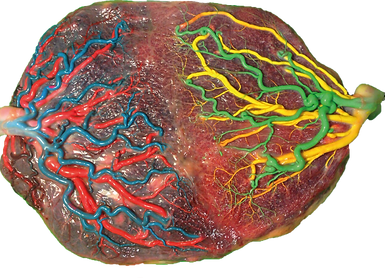Diagnostics after birth
Because of the absence of external warning signs for the mother, TAPS is in some cases missed during pregnancy and diagnosed after birth.
Blood examination
To diagnose TAPS after birth, the doctors will look at the hemoglobin level in the babies' blood. Hemoglobin is a protein found in red blood cells and gives blood its red color. Its job is to carry oxygen throughout the body. The anemic donor has low counts of red blood cells and therefore has a low level of hemoglobin. The polycythemic recipient on the other hand, has an excess of red blood cells, and shows in its turn high levels of hemoglobin. In addition to the hemoglobin levels, the doctors will study the reticulocytes (young red blood cells). In response to anemia, the TAPS donor has produced a lot of new, young red blood cells. In the recipient, the opposite is seen: as a result of the high amount of red blood cells, there are only a few young red blood cells.
DONOR

Hemoglobin
laag

Reticulocytes
hoog
RECIPIENT

Hemoglobin
hoog

Reticulocytes
laag
Placental examination
Because the vessels on the placenta are the cause of TAPS, the placenta will go for color dye injection study after birth. During this examination, color dye will be injected into the placental vessels of both babies. By performing color dye injection, the minuscule connecting vessels responsible for TAPS can be uncovered.
INJECTED PLACENTA OF TWINS WITH TAPS


connecting vessel


connecting vessel
SPONTANEOUS TAPS
POST-LASER TAPS
Placenta of a monochorionic twin diagnosed with spontaneous TAPS. The yellow and green vessels are from the TAPS donor, the red and blue vessels are from the TAPS recipient. The close-up photo shows a tiny red-green vascular connection. The donor pumped blood through the green vessel to the recipient's red vessel, causing the donor to develop anemia and the recipient to develop polycythemia.
Placenta of a monochorionic twin that has received a laser surgery for twin-twin transfusion syndrome. One very small connecting vessel is missed during the procedure, causing the twin to develop TAPS. The yellow and green vessels belong to the TAPS recipient, the red and blue vessels belong to the TAPS donor. On the close-up photo, a minuscule blue-yellow connecting vessel is seen. The donor pumped blood through the blue vessel into the recipient's yellow vessel, causing the donor to slowly develop anemia and the recipient to develop polycythemia.
